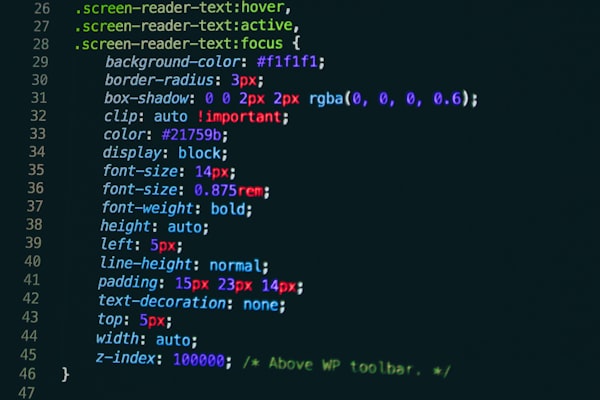1. Introduction: Why CSS4 is a Game Changer for Web Development
Hold onto your style sheets, folks! If you thought CSS3 was like that fancy blender you got last Christmas, then CSS4 is the entire kitchen remodel with a voice-controlled coffee machine thrown in! 🚀 But seriously, why is the web dev community buzzing louder than a caffeine-fueled coder on a deadline? Let's break it down.
Firstly, CSS (Cascading Style Sheets) has long been the unsung hero behind the internet's most dazzling webpages. You know, the ones that make you question your life choices because they're just so darn pretty. CSS3 brought us rounded corners, shadows, and gradients. Those were like the cherries on top of our digital sundaes.
But now? CSS4 comes swaggering in, not just adding cherries, but sprinkling gold flakes, pouring caramel sauce, and maybe even adding a touch of that mystical unicorn sparkle. It's aiming to revolutionize the way we approach web design and development.
While many might ask, "Do we really need another version?", the savvy devs know that evolving is the name of the game in our tech-obsessed world. CSS4 promises more flexibility, better performance, and the kind of customization previously only available to wizards or those with a direct line to the coding gods.
So, as we delve into this roller coaster of style sheet evolution, grab your virtual popcorn and prepare to be both educated and entertained. Because trust me, by the end, you'll be chanting 'CSS4 for President!' or maybe just updating your websites. Either way, it's going to be epic! 🎉
2. What Makes CSS4 Different: Key Features and Enhancements
Well butter my biscuit and call me a developer, because CSS4 is here and it's not just playing in the same old web sandbox! If CSS were a rock band, CSS4 would be the remastered greatest hits album with some previously unreleased bangers. So, what’s the big hullabaloo about? Buckle up, my pixel-pushing pals, and let’s dive into the crispy crunch of these new enhancements.
- Nested Rules: Remember the days when your code looked like a plate of spaghetti, but not as delicious? Well, with CSS4’s nested rules, organization just got a spicy upgrade! Now you can nest selectors within selectors. So, instead of a tangled mess, you get a neat, well-layered trifle of coding joy.
- Selectors Level 4: Think of this as the detective magnifying glass for your web elements. With the likes of
:matches()and:not(), the new selectors bring a magnanimous finesse in selecting just what you want, when you want. Sherlock Holmes, eat your heart out! - Custom Properties: Imagine if you could have a secret handshake or password with your code. That’s what CSS4's custom properties feel like. They allow variables in your styles, meaning you can adjust settings across the board with a mere tweak. Efficiency just got a new poster child.
- Extended Color Features: Ever felt limited by the color palette? CSS4 says, "Hold my hexadecimal!" With a broader range of colors and new ways to define them, your website can now sport the hues of a million rainbows (or just that perfect shade of millennial pink you were craving).
- Env() Function: Responsive design just got an upgrade. With the
env()function, you can utilize environmental constants, making sure your design fits like Cinderella’s shoe, regardless of the device. - Aspect-Ratio Property: If you've ever grappled with responsive image ratios, CSS4 comes in like a knight in shining armor. The
aspect-ratioproperty ensures that your images always look their best, whether on a cinema display or a teeny-weeny smartwatch.
In the grand theater of web development, CSS4 is like that lead actor who not only knows every line but even throws in some ad-libs that have the audience in stitches. So, if you're looking for a robust, versatile, and, dare we say, sassy upgrade to your styling prowess, CSS4 might just be your golden ticket.🌟
3. The Journey from CSS3 to CSS4: A Brief History
Ah, gather 'round fellow pixel wranglers and style sheet sorcerers, for it's storytime! 📜 Our tale begins in the land of CSS3, where webpages danced in gradients and shadows, basking in the newfound glory of animations and transitions. But, as in every epic, there's always another chapter. And so begins our enchanting tale of the journey from CSS3 to the dashing hero of our story, CSS4.
- The Age of Rounded Corners: Remember when rounded corners were the new black? CSS3 made them simpler than pie (mmm, pie). But while we were playing with our new toys, the wizards behind the curtain were already dreaming of the next big thing.
- Transitions, Transforms, and Animations: CSS3 felt like we’d been handed the keys to the animation kingdom. Slide here, rotate there, and spin everywhere! The web was moving, quite literally. But as with every great dance party, there's always the anticipation of the next song.
- Responsive Web’s Adolescence: Media queries were the magic spells of their time. Suddenly, our designs flexed and flowed across devices like a well-rehearsed flash mob. Yet, as with any teenager, there were growing pains and rebellious streaks, hinting at the maturity CSS4 would soon bring.
- The Quest for More: As designers and developers began to push boundaries, they also pushed for more from CSS. While CSS3 felt like a smorgasbord of options, there were still dishes yet to be tasted. Enter the murmurs of CSS4.
- Dawning of the CSS4 Era: And lo and behold, the whispers grew louder. The call for more selectors, more variables, and even more flexibility became a clarion call. As if answering a prophecy, CSS4 began to emerge from the mist, promising a new age of web development magic.
- Community and Collaboration: One cannot discuss the evolution without giving a tip of the hat to the incredible community. Forums, blogs, and the digital equivalent of town criers, Twitter users, played their part. They tested, they tweaked, and they passionately debated, helping to mold the framework of CSS4.
As we stand on the shoulders of the CSS giants before us, it’s clear that this isn't just a history lesson. It's a testament to the ever-evolving world of web development. From the humble beginnings of static pages to the dynamic, interactive masterpieces of today, CSS's journey is a reminder that in the web world, the only constant is change. And cookies. Always cookies. 🍪🚀
4. Syntax Changes: Understanding the New Structure of CSS4
Ahoy, brave travelers of the CSS odyssey! We've danced through history, but now it's time to get our hands slightly greasy. (But fear not, it's the good kind of greasy – think fresh pizza or gourmet fries!) Let's decode the cryptic runes of CSS4's syntax changes. Because, just like updating your favorite app, there's bound to be a few new buttons and perhaps a swipe or two you weren’t expecting. 🍕💡
- Hello, Nesting!: CSS4 invites us to think inside the box. Literally. By allowing us to nest rules within rules, our code's structure becomes cleaner than a cat after a catnip-fueled grooming session. This means fewer repetitions and more straightforward logic paths. Nesting, you're the cozy blanket of coding!
- Specificity Simplified: If you've ever felt like you're playing a game of "Whack-a-Mole" with selectors, rejoice! CSS4 brings a more nuanced approach to specificity, so your styles apply where you want them, without those pesky unexpected overrides. It's like having a GPS for your code.
- Introducing the ‘is’ and ‘where’ Pseudo-classes: Move over, Shakespeare, there’s a new "to be or not to be" in town. With the
:is()and:where()pseudo-classes, grouping selectors has never been more poetic. They're the dynamic duo ready to save Gotham, or at least, your webpage. - Var() Levels Up: While CSS3 introduced us to the wonders of
var(), CSS4 says, "Hold my code!" Now, we can use more complex values and even combine them with other functions. It’s like turning your simple vanilla ice cream into a sundae with all the toppings. - Relational Pseudo-classes: With features like
:has(), we're diving into a relationship status with our elements that’s more intricate than any Facebook option. It allows for more refined selection based on child elements, turning your style targeting from a sledgehammer to a surgeon's scalpel. - Extended Combinators: If you ever wanted your selectors to mingle, chat, and maybe even have a little soirée, the extended combinators in CSS4 have got you covered. With deeper connections between elements and their styles, it's like the ultimate networking event for your code.
Peeling back the layers of CSS4's syntax changes is akin to exploring the secret menu at your favorite cafe. Sure, the classics are great, but oh, the delight in discovering that caramel-drizzled, triple-shot, whipped cream-topped coding concoction! Let's raise our metaphorical mugs to the elegant intricacy of CSS4. Cheers! 🍻🖥️
5. CSS4 and Responsiveness: Making Websites More Adaptive
Ah, responsiveness! It's like the swiss army knife of web design - always there when you need it, always impressing with its multifaceted tricks. And if CSS3 was the trusty pocket knife, then CSS4 is the deluxe model with the built-in espresso machine. ☕️🔪 Let's unravel how CSS4 is taking responsiveness from a simple "fit and stretch" routine to an art form resembling a Cirque du Soleil performance.
- Container Queries: We've lived in the age of media queries for so long, shaping our designs by the viewport's whims. But with CSS4's container queries, it’s less about the screen and more about the container's size. It's like tailoring your outfit based on the event, not just the weather. Vogue, here we come!
- The Mighty
env(): Remember the envy (pun intended!) this function stirred up earlier? It gets even better. With theenv()function, our designs can adapt based on certain device environment variables. Think of it as a chameleon adjusting to its surroundings, ensuring your designs always feel right at home. - Intrinsic Sizing: No more guessing games! With CSS4, elements can size themselves based on their content, ensuring they fit just right. It's like every element went to finishing school and learned impeccable posture and manners.
- Aspect-Ratio Wonders: Mentioned before but worth highlighting again, the
aspect-ratioproperty ensures fluidity like never before. Whether you’re on a widescreen monitor or a portrait-mode smartphone, your elements maintain their proportionate beauty. - Landscape and Portrait Pseudo-classes: CSS4 introduces the
:landscapeand:portraitpseudo-classes. With these, the orientation of your device won’t catch your design off guard. It's akin to having an ambidextrous website, comfortable in any orientation. - Multi-Column Layout Enhancements: Ever wanted your content to flow like a river through multiple columns? CSS4 fine-tunes the multi-column properties, offering more flexibility and fluidity. It’s like transforming your webpage into an elegant magazine spread.
To wrap it up, CSS4’s take on responsiveness isn’t just about squishing and expanding. It's about ensuring websites gracefully pirouette, somersault, and glide across any and every device. It's a symphony of adaptability, ensuring every user, no matter the device or screen size, gets the VIP front-row seat experience. So, as you twirl into the realm of responsive design with CSS4, don’t just adapt—mesmerize! 🎭📱🖥️
6. Variables and Customization in CSS4: A Leap Forward
Step right up, ladies and gentlemen, for the grand unveiling of the couturier's dream in the web world: Variables and Customization in CSS4! If CSS3 brought the concept of tailor-made designs to the party, CSS4 arrives in a diamond-studded limousine, ready to dazzle with customization levels that make even haute couture seem off-the-rack. 🎩✨
- Beyond the Basics with
var(): While CSS3 introduced us to the magic of variables via thevar()function, CSS4 takes it to a star-studded gala. With enhanced abilities to combine variables and introduce more complex calculations, it's like crafting a potion that adjusts itself based on the moon phase. Or in our case, user preferences. - Scoped Variables: Gone are the days when variables were the global celebrities of your stylesheet. With CSS4, they can be local heroes too, thanks to scoped variables. They function within specific sections of your code, offering precision akin to a surgeon's scalpel.
- @property - Making Variables Explicit: The
@propertyrule is like the director’s commentary on a movie. It provides context and meaning to your variables, letting you set type, initial value, and inheritance, ensuring every element knows its part in the grand performance. - Dynamic Themes with CSS4 Variables: Think of this as wardrobe changes for your website. With enhanced variables, switching between light mode, dark mode, or any other theme is smoother than a jazz tune on a Saturday night.
- Improved Fallbacks with
env(): CSS4 doesn’t just stop at customization; it thinks ahead. With improved fallback options using theenv()function, your design won’t crumble like a cookie if a user’s system doesn't support a particular feature. It'll gracefully degrade, ensuring the user experience remains top-notch. - The Magic of
calc(): If you thoughtcalc()was a wonder in CSS3, hold onto your monocle! CSS4 amplifies its capabilities, allowing it to work seamlessly with variables, resulting in dynamic calculations that would make even the most seasoned mathematician tip their hat in admiration.
The leap from CSS3 to CSS4 in terms of variables and customization is not just a step; it’s a quantum leap. Imagine not just designing a webpage, but crafting a unique experience for every user, every time. The tapestry of possibilities is richer, the canvas broader, and the paintbrush more intricate. So, to all the web maestros out there, it’s time to compose your magnum opus with CSS4’s symphony of variables and customization! 🎨🎻🚀
7. Performance Benefits: How CSS4 Improves Website Speed
Ladies and gents, geeks and nerds, lean in closely because we're diving into the turbocharged realm of CSS4! If web performance were a racetrack, CSS4 would be that souped-up car, complete with flashy decals, leaving others in its dust. But what is it about this latest iteration that makes it the Usain Bolt of the stylesheet world? Let's slam the gas pedal and find out! 🏎️💨
- Leaner Code, Faster Loads: With the introduction of advanced selectors, nesting, and modularized styles, your CSS files can be more concise. This isn’t just about elegance (though that's a bonus); leaner code means quicker parsing and faster rendering. It’s the difference between a slim, agile cat and... well, an adorable but sluggish chubby cat.
- Smarter Caching with Variables: Remember those snazzy variables we talked about? They're not just for show. By manipulating variables instead of entire stylesheets for dynamic themes, browsers can cache more efficiently, ensuring that returning visitors get lightning-fast load times. It's like having a VIP express lane just for regulars!
- Improved Render Timing: With the enhanced
containproperty and other layout-based enhancements in CSS4, browsers have a clearer roadmap for rendering. They can prioritize, skip, or delay non-essential rendering tasks, making the initial page load feel as swift as a hot knife through butter. - Optimized Animations and Transitions: While CSS3 made the web dance, CSS4 refines the choreography. It offers improved control over GPU acceleration, meaning animations are smoother and less taxing on the system. It's as if your webpage enrolled in a ballet class and emerged as the principal dancer.
- Selective Loading with Media Features: Using the enhanced media queries in CSS4, you can deliver styles selectively, based on device capabilities. It ensures that a 4K desktop doesn’t get the same resources as a 320px-wide phone. It's like custom tailoring: Why wear an oversized suit when you can have a perfect fit?
- Enhanced Compatibility Reduces Polyfills: CSS4's broader compatibility spectrum means fewer polyfills and hacks. This not only streamlines your code but also reduces the processing power required, leading to quicker site interactions. Imagine shedding those heavy winter layers and feeling light and breezy in spring!
So, the next time someone talks about the flashy, glitzy features of CSS4, don't forget to tip your hat to the unsung heroes: the performance benefits. Like the pit crew at a race, they may not always be in the spotlight, but they ensure that your website speeds past the finish line, time and time again. Fasten your seat belts, folks, because with CSS4, the web's going at warp speed! 🚀🌐💡
8. Browser Support: What to Expect from Various Web Browsers
Ah, browser support. The age-old dance of web designers everywhere. If web development were a dinner party, this would be the dish that everyone examines with a discerning eye. Will it be delightful, or a slight disaster? Well, pull up a chair and grab your finest silverware, as we dissect how different browsers are catering to the lavish feast of CSS4. 🍽️🌐
- Google Chrome - The Trendsetter: Always eager to embrace the new, Chrome has been swift to adopt CSS4 features. Its frequent update cycle means it's often first to the party, showing off the latest styles like a fashionista at a gala. With Chrome, expect a sumptuous banquet of CSS4 capabilities.
- Mozilla Firefox - The Thoughtful Innovator: Firefox, with its strong focus on developer tools, doesn't just support features; it provides a robust toolkit to understand and debug them. While occasionally a beat behind Chrome, it ensures that when CSS4 features arrive, they're as polished as a gleaming chandelier.
- Safari - The Refined Connoisseur: Apple's Safari, ever the connoisseur of aesthetics and performance, is selective but effective in its adoption. While it might not be the first to roll out every feature, when it does, you can bet it'll be smooth and efficient, like a butler serving high tea.
- Microsoft Edge - The Adaptive Newcomer: Since its Chromium adoption, Edge has been more in sync with Chrome's pace. While previously it might have been the wild card of the group, the new Edge is now a reliable attendee, ready to dive into the CSS4 spread with gusto.
- Opera - The Eclectic Enthusiast: Often overlooked but not to be underestimated, Opera brings its own flavor to the party. With its unique features like built-in VPN and ad-blocker, it ensures a balanced approach, marrying its individuality with a keen appetite for CSS4 enhancements.
- The Legacy Browsers - The Nostalgic Relatives: Internet Explorer and older versions of many browsers are like your great-aunt who still uses a rotary phone. Charming, but not quite up-to-speed. Here, polyfills and fallbacks will be your trusty companions, ensuring no one misses out on the fun.
- Mobile Browsers - The Pocket-sized Powerhouses: As the world goes mobile, so does CSS4. Mobile browsers, whether it's Chrome on Android or Safari on iOS, are keenly adapting to the responsive wonders of CSS4. It's like fitting a gourmet meal into a bento box — compact, but no less delicious.
In the grand ballroom of web development, while each browser waltzes to its own tune, the shared melody is unmistakable: the harmonious chords of CSS4. And as developers and designers, our task is to be the maestros, ensuring the symphony plays on, regardless of the instrument. Encore! 🎻🎶🌍
9. Practical Applications: Real-world Examples of CSS4 in Action
Let's be real: theory is the comfy armchair of knowledge, but practical applications? They're the adrenaline-pumping roller coaster rides of the web world. With CSS4 dropping more features than a pop star drops albums, it's high time we spotlight how these features have already been turning the digital landscape into a work of art. Grab your virtual VR glasses and let’s embark on this awe-inspiring tour! 🎢🌐
- The Dynamic Magazine Layout: Remember the chic multi-column layouts we talked about? Top online magazines have been using these to create print-like reading experiences, turning every scroll into a flip of a glossy page. It's the web's answer to haute couture fashion magazines!
- The Ever-Adaptive E-commerce Site: With container queries and improved responsiveness, online stores now adapt not just to screen sizes, but also to the size of their own containers. Product grids now auto-adjust based on available space, ensuring the shopping experience is as smooth as silk. Cart abandonment due to design? That's so last season!
- The Artistic Portfolio with
aspect-ratio: Many artists and photographers have embraced theaspect-ratioproperty to create fluid galleries. Regardless of your device, their masterpieces maintain perfect proportions, making every pixel a symphony of visual delight. - Interactive Infographics and the Magic of Variables: Several news sites and ed-tech platforms have employed CSS4 variables for interactive infographics. Change a date, adjust a slider, and watch the entire visual story shift using the magic of CSS4. It's like having a time machine powered by stylesheets!
- The Dawn of Dynamic Themes: Beyond the simple light and dark modes, websites have begun offering theme customizations based on user preferences, time of day, or even the season, thanks to enhanced variables. Your winter browsing now feels like a cozy log cabin, and your summer? A tropical beach retreat.
- Smooth Animations for Storytelling: Digital storytellers and marketers rejoice! CSS4’s optimized animations ensure narratives flow smoothly, turning web pages into cinematic experiences. It's as if Spielberg decided to dabble in web design!
- Gaming Interfaces Level Up: Online gaming platforms have leveraged the performance enhancements of CSS4 to create seamless, immersive HUDs (Heads-Up Displays) and menus. Laggy interfaces? They're in the same vault as floppy disks now.
To sum it up, CSS4 isn't just a spec sheet of fancy features; it’s a tangible revolution in the digital realm. These real-world applications are proof that we're not just coding; we're crafting experiences, sculpting narratives, and, in essence, painting the vast canvas of the web with strokes of innovation. So, the next time you spot a sleek design or an ingenious UI/UX solution, tip your hat; there's a good chance CSS4 is the unsung hero behind it! 🖌️🎨🌍
10. Conclusion: What CSS4 Means for the Future of Web Design
As we reach the end of our whirlwind adventure through the galaxy of CSS4, it's time to park our spaceship, gaze at the stars, and reflect on what this new frontier signifies for the cosmos of web design. Grab your space blanket and hot cocoa; let's get philosophical! ☕🌌
- The Era of Fluidity: If the web design of yesteryears was a rigid sculpture, CSS4 transforms it into flowing watercolor. With unmatched adaptability and dynamism, web pages are no longer static entities but living, breathing organisms that respond, adapt, and evolve.
- A Renaissance of Creativity: Much like the Renaissance period that unfurled a tapestry of art and innovation, CSS4 empowers designers with tools that spark creativity. We're on the brink of a design renaissance where barriers are falling, and imagination reigns supreme.
- The Democratization of Design: With enhanced compatibility and fewer cross-browser hiccups, CSS4 narrows the gap between designers' visions and the actual online experience. Web design is becoming more democratic, where the artist's intent and the viewer's experience converge harmoniously.
- Elevated User Experiences: With rapid loading times, adaptive layouts, and interactive elements, user experience (UX) is getting the royal treatment. CSS4 ensures that visitors aren't just viewers, but active participants in a digital narrative.
- Green Signals for Performance: The spotlight on performance means we're heading towards a greener, more sustainable web. Faster load times and efficient rendering translate to lesser energy consumption and, in turn, a smaller carbon footprint. The future with CSS4 is not just bright; it's eco-friendly!
- The Horizon of Integration: The convergence of variables, modules, and other features hints at a future where CSS integrates more seamlessly with other tech stacks. Imagine a world where CSS, JS, and HTML dance in perfect rhythm, creating a symphony of synergized web operations.
As we pack up our telescopes and fold our maps, one thing is crystal clear: CSS4 is more than just an upgrade; it's a paradigm shift. The boundaries of what's possible in web design are expanding, and we're all astronauts charting unexplored territories. The universe of the web is vast, mysterious, and with CSS4 as our guiding star, the future looks nothing short of stellar.
To infinity and beyond, web designers! 🚀✨🌐








